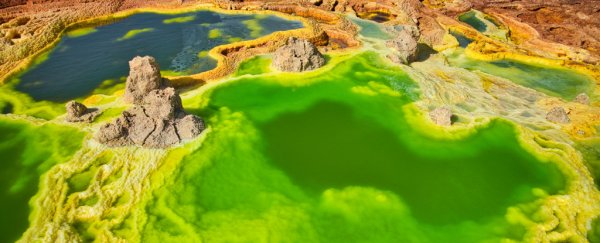Where there's water, there's life, the thinking loosely goes. New evidence suggests starkly otherwise – or at least identifies some harsh new parameters on where life and water may (or may not) be able to co-exist.
To find these limits, scientists travelled to one of the most extreme and inhospitable environments on Earth: the Dallol geothermal springs in Ethiopia's Danakil Depression.
This hellish, salty waterworld is generally considered the hottest inhabited place on the planet, but it's unique for all sorts of reasons that go beyond mere stifling heat.
The Dallol landscape is punctuated by cratered lakes of hyperacidic, hypersaline water coloured in a vibrant palette of greens, yellows, oranges, and browns.
It looks pretty from a distance in a kind of otherworldly way, but don't get too close; the heated pools make for a toxic, gas-saturated brine, courtesy of a smouldering volcano hidden underneath the exotic surface.
Because of Dallol's extreme environment, the area has long fascinated scientists. One publicised research expedition in 2016 set out to find what – if anything – might dwell in such unwelcoming, alien surrounds.
"It is an amazing but hostile place… the chlorine vapour burned our airways," expedition leader Felipe Gómez from Spain's Centro de Astrobiologia said at the time.
"Any microorganisms living here will be extremophilic microbes of a major interest to astrobiologists."
The results of that survey got published only a few months ago, with the team reporting what they said was the first evidence of life existing among the hot, acidic springs: "ultra-small microorganisms" measuring only nanometres in size.
Now, a new study led by a separate team of scientists disputes the seeming discovery of this archaea – or at least the relevance of the finding.
"We refute the recent claim of life in the polyextreme Dallol hydrothermal ponds," microbiologist Jodie Belilla from the Université Paris-Sud in France tweeted in June, when a pre-print of her team's counter-argument became first available.
"Is there life in the hyperacidic + hypersaline Dallol pools?," the researchers asked.
"We say no, based on combined molecular and microscopy techniques, though we find many airborne and human-associated contaminants."
In their now peer-reviewed findings, which were published this week, the team used a range of analytical methods to investigate a broad range of samples taken from four zones within the Dallol geothermal complex in three field expeditions between 2016 and 2018.
While they detected evidence of archaea-based life too in addition to signals of what might be bacterial gene sequences, the team says the majority of the hits were probably a red herring.
"Most of them were related to well-known molecular biology kit and laboratory contaminants, whilst others were human-related bacteria probably introduced during intensive afar and tourist daily visits to the site," the authors explain in their paper.
According to the team, the results strongly suggest that active, naturally occurring microbial life is not to be found in the Dallol ponds and lakes system.
"We identify two major physicochemical barriers that prevent life from thriving in the presence of liquid water on Earth and, potentially, elsewhere, despite the presence of liquid water at the surface of a planet being a widely accepted criterion for habitability," the researchers explain.
One of these barriers is magnesium-dominated brines, which induces cells to break down through a process known as chaotropicity; the other is a certain, toxic level of intense hyperacid–hypersaline combination, suggesting "molecular adaptations to simultaneous very low pH and high salt extremes are incompatible beyond those limits".
Of course, absence of evidence is not evidence of absence. Just because extensive sampling of Dallol's salty sauna hasn't revealed life-forms more complex than microfossils doesn't prove they're not there at all.
But until more robust analyses can convincingly indicate otherwise, Belilla and co. remain assured that Dallol's most inhospitable corners are incapable of colonisation.
"The extensive occurrence of abiotic, mostly Silicon-rich biomorphs mimicking the simple shape and size of ultra-small cells in the hydrothermally influenced Dallol settings reinforces the equivocal nature of morphological 'microfossils' and calls for the combination of several biosignatures before claiming the presence of life on the early Earth and beyond," the team concludes.
The findings are reported in Nature Ecology & Evolution.
